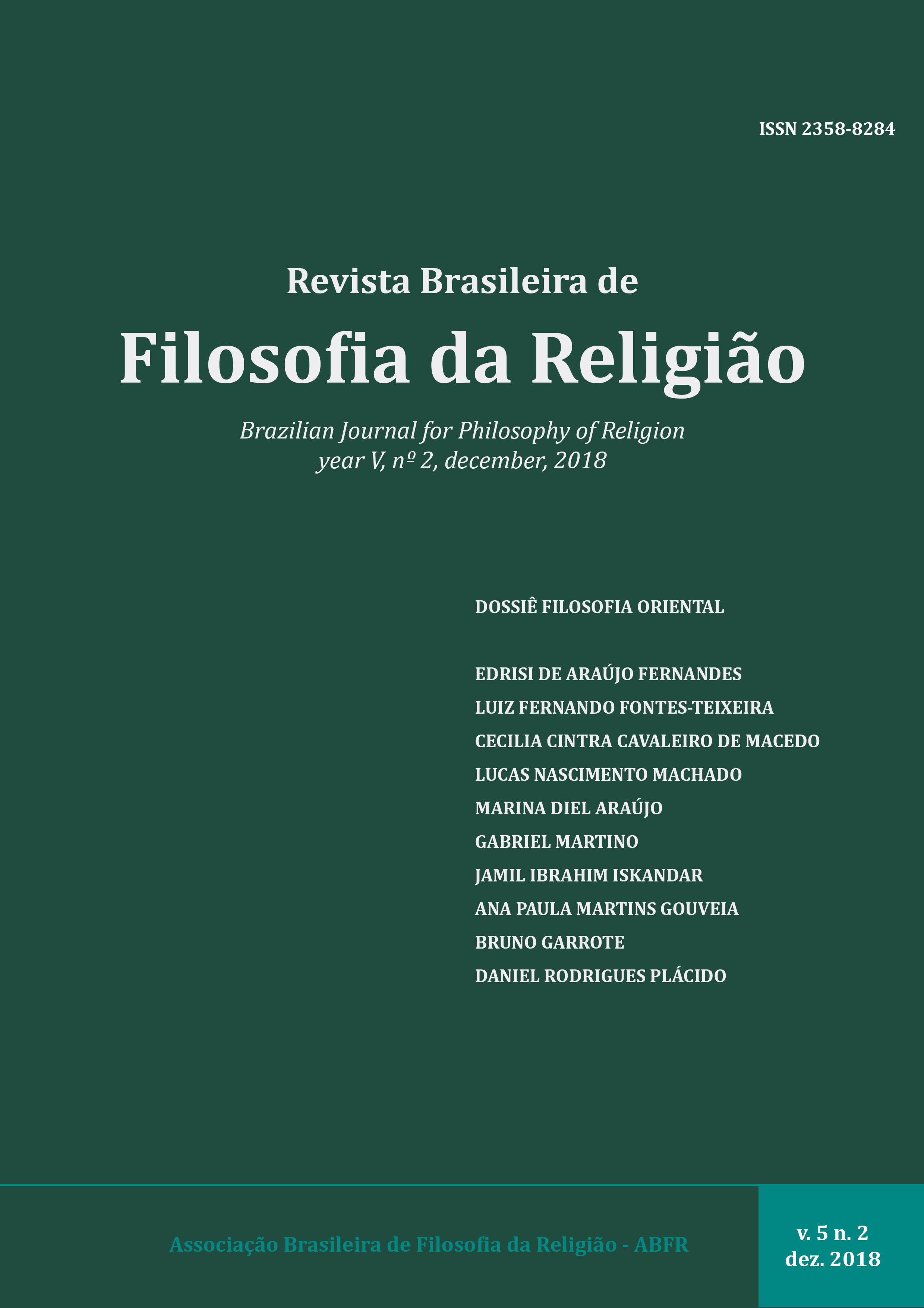Issues concerning the theological element of classical Yoga Philosophy and their reassessment in two contemporary readings of the Yogasūtra.
DOI:
https://doi.org/10.26512/2358-82842018e26245Resumen
En el presente trabajo examinamos la concepción teológica del YogasÅ«tra y dos interpretaciones novedosas propuestas acerca de esta temática. En un primer momento discutimos el trabajo de algunos autores considerados como autoridades en el tema durante el siglo XX y su visión crítica del tema. Examinamos, a continuación, los pasajes principales del YogasÅ«tra en los que aparece la noción de Ä«Å›vara y finalmente analizamos dos interpretaciones recientes del YogasÅ«tra que proporcionan elementos de valor para nuestro analisis de cómo debemos comprender la noción de Ä«Å›vara en el texto. Discutimos la posición de Maas, quien sostiene que el YogasÅ«tra y el comentario atribuido a Vyãsa (conocidos como el PãtañjalayogaÅ›ãstra) deben ser tomados como formando parte de una unidad compuesta por un mismo autor, posiblemente Patañjali. También consideramos la traducción y comentario de Bryant del YogasÅ«tra, donde el autor afirma que Patañjali fue un devoto de un dios personal como Kṛṣṇa, y que su noción de Ä«Å›vara-praṇidhãna puede ser entendida como "devoción a dios". Finalmente discutimos la compatibilidad mutua de ambas interpretaciones.
Referencias
BRONKHORST, J. (1981). Yoga and seśvara Saṃkhya. Journal of Indian Philosophy, 9, 3: 309-
BRYANT, E. F. (2009). The YogasÅ«tras of Patañjali. A new Edition, Translation and
Commentary. With insights from the traditional commentators. New York: North Point Press.
DICKSTEIN, J. (2015). “Richard Garbe, German Indology and the Messiness of (A)theistic
Saṃkhya”. SAGAR: South Asia Research Journal xxiii: 2-34.
EDGERTON, F. (1924). “The Meaning of Sankhya and Yoga”. The American Journal of
Philology, 45, 1: 1-46.
ELIADE, M. (2009). Yoga Immortality and Freedom. With a new Introduction by David Gordon
White. Translated from the French by Willard R. Trask. Princeton and Oxford: Princeton
University Press. First original French edition from 1954.
FEUERSTEIN, G. (1987) “The concept of God (Īśvara) in Classical Yoga”. Journal of Indian
Philosophy, XV: 385-397.
FRAUWALLNER, E. (1973). History of Indian Philosophy. The Philosophy of the Veda and of
the Epic. Vol I: The Buddha and the Jina. The Saṃkhya and the Classical Yoga System. Translated
from the original German into English by V. M. Bedekar. Delhi: Motilal Banarsidass.
GARBE, R. (1894). “Outlines of a History of Indian Philosophy”. The Monist, 4, 4: 580-598.
JACOBI, H. (1929). “Uber das ursprüngliche Yogasystem”. Sitzungsberichte der Preußischen
Akademie der Wissenschaften, Phil.-hist. K1.: 581-624.
LARSON, G. and BHATTACHARYA, R. S. (2008). Yoga: India´s Philosophy of Meditation.
Vol. XII of The Encyclopedia of Indian Philosophies. Edited by Karl H. Potter. Delhi: Motilal
Banarsidass.
MAAS, Ph. (2006). Samadhipada: Das erste Kapitel des Patanjalayogaśastra zum ersten Mal
kritisch ediert. Wien: Shaker.
MAAS, Ph. (2013). “A concise historiography of Classical Yoga Philosophy” In Periodization
and Historiography of Indian Philosophy, by Franco, E. Sammlung de Nobili, Institut fur
Sudasien-, Tibet- und Buddhismuskunde der Universitat Wien: 53-90, 2013.
MARTINO, G. (2015). “Aspectos lingüísticos, estilísticos y teoréticos del YogasÅ«tra”, Exlibris,
Revista del departamento de Letras, UBA 4: 429-444.
NICHOLSON, A. (2010). Unifying Hinduism: Philosophy and Identity in Indian Intellectual
History. New York: Columbia University Press.
PFLUEGER. Ll. (2005). “Person, purity, and power in the YogasÅ«tra”, In Theory and Practice of
Yoga: Essays in Honour of Gerald James Larson by Larson G. J. & Jacobsen K. A. Brill: 110 ”“
RAGHAVAN, V. (1980). “Abhinavagupta and the Bhaá¹£ya on the YogasÅ«tras”, Annals of Oriental
Research (Madras), 3, 1-6, 1938-1939, reprinted in: Abhinavagupta and his Works. Chaukhambha
Oriental Research Studies 20, Varanasi: 78-87.
TOLA, F. and DRAGONETTI, C. (2006). La Filosofía Yoga. Un camino místico universal.
Barcelona: Kairós

